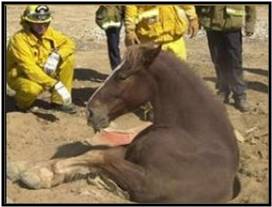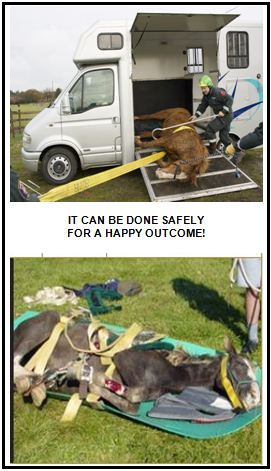Large Animal Rescue
Scroll down to bottom of page to download fact sheets and information.

Equine Emergency Rescue. To buy a copy of the book go to www.equineER.com cost $29.95
An introduction to Large Animal Rescue
Large Animal Rescue is defined as the removal of a large animal from a place of danger to a place of safety by the most humane method, with overriding regard for the safety and welfare of responders as well as members of the public.
The rescue of a horse is an infrequent, highly dangerous emergency that is often mishandled. Fire and Rescue, SES, veterinarians and RSPCA Inspectors are not routinely trained, and are generally ill-prepared, to respond effectively to the wide variety of scenarios presented by horse rescues. However, these professionals must be involved to ensure the safety of humans and animals and prevent the incident turning into a disaster. There cannot be Standard Operating Procedures (SOP) for horse rescues because every rescue is unique. So, Large Animal Rescue is about carrying out a risk assessment and deciding that if the animal cannot be rescued safely, it cannot be rescued at all.
 Horses in distress are considered an immediate danger to life or health and a rescue incident is no place for untrained personnel and distressed owners or onlookers. Invariably, there is immense pressure from owners, veterinarians and willing but untrained helpers for emergency responders to ‘do something’. Risk assessment goes out the window, a lack of understanding on all sides leads responders to engage in unsafe practices that place everyone at the scene at high risk of injury or death and, consequently, the viability of the animal is reduced.
Horses in distress are considered an immediate danger to life or health and a rescue incident is no place for untrained personnel and distressed owners or onlookers. Invariably, there is immense pressure from owners, veterinarians and willing but untrained helpers for emergency responders to ‘do something’. Risk assessment goes out the window, a lack of understanding on all sides leads responders to engage in unsafe practices that place everyone at the scene at high risk of injury or death and, consequently, the viability of the animal is reduced.
Horse rescue:
Each of the 1.3 million domesticated horses in Australia, no matter how quiet or well educated, has the potential to become involved in an emergency incident and need to be rescued. Two of the most common rescues are of horses trapped in mud and incidents involving horse floats but horses also fall down cliffs and into ditches, gullies, sinkholes and septic tanks and they get stuck in quicksand.

When it is not possible to help the horse to self-rescue it is vital not to cause additional injuries or death. Tragically, if a horse is involved in an emergency situation he could sustain serious injuries or be killed, not necessarily from the original incident but from the rescue attempts of well-meaning but untrained personnel who are not aware that specialised rescue techniques for large animals exist and that the human rescue techniques of primary triage, first aid and medical support can be applied to horses.
Injured humans are never removed from an accident scene by being dragged out with ropes tied around their necks, wrists or ankles but that is exactly how horses are manhandled, often with devastating consequences. Horses are routinely strangled, drowned and dropped and rescuers themselves are often severely injured or killed because they don’t understand how potentially explosive and dangerous a trapped horse can be.
 Because of their volatile nature, the dangers inherent in rescuing horses cannot be overemphasised and responders must treat each rescue exactly as if it contained a Hazardous Material – a dangerous object that will explode without warning. For the safety of responders and the victim, it is critical to involve an equine or large animal vet for the key role of sedation and anaesthesia at a large animal rescue. With advances in veterinary medicine, many large animals that previously would have died now have a viable chance of surviving injuries. However, responders must work within a defined system and do it before the situation turns into a disaster.
Because of their volatile nature, the dangers inherent in rescuing horses cannot be overemphasised and responders must treat each rescue exactly as if it contained a Hazardous Material – a dangerous object that will explode without warning. For the safety of responders and the victim, it is critical to involve an equine or large animal vet for the key role of sedation and anaesthesia at a large animal rescue. With advances in veterinary medicine, many large animals that previously would have died now have a viable chance of surviving injuries. However, responders must work within a defined system and do it before the situation turns into a disaster.
These techniques work. Twenty years ago, only a tiny four to ten percent of the one thousand large animal rescues carried out in the UK each year were deemed to be successful – that is, they did not maim, severely injure or kill the animals involved. However, when advisers who were trained in technical large animal rescue techniques joined rescue teams, the percentage of successful rescues was raised to 96% (P. Baker 2006).

An Introduction to Large Animal Rescue